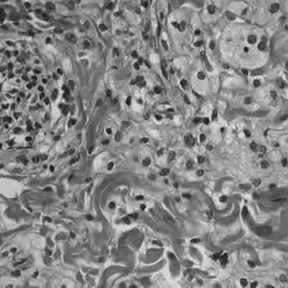Erdheim-Chester disease
| Erdheim-Chester disease | |
 | |
|---|---|
| ICD-10 | C96.1 |
| ICD-9 | 202.3 |
| DiseasesDB | 29792 |
| MeSH | D031249 |
|
Erdheim-Chester disease Microchapters |
|
Diagnosis |
|---|
|
Treatment |
|
Case Studies |
|
Erdheim-Chester disease On the Web |
|
American Roentgen Ray Society Images of Erdheim-Chester disease |
|
Risk calculators and risk factors for Erdheim-Chester disease |
Editor-In-Chief: C. Michael Gibson, M.S., M.D. [1]
Synonyms and keywords: Erdheim-Chester syndrome; polyostotic sclerosing histiocytosis
Overview
History
Clinical Presentation
Histology
Histologically, ECD differs from Langerhans cell histiocytosis (LCH) in a number of ways. Unlike LCH, ECD does not stain positive for S-100 or CD 1a, and electron microscopy of cell cytoplasm does not disclose Birbeck granules.[1] Tissue samples show xanthomatous or xanthogranulomatous infiltration by lipid-laden or foamy histiocytes, and are usually surrounded by fibrosis. Bone biopsy is said to offer the greatest likelihood of reaching a diagnosis.
Diagnosis
Radiologic osteosclerosis and histology are the main diagnostic features. Diagnosis can often be difficult because of the rareness of ECD as well as the need to differentiate it from LCH. A diagnosis from neurological imaging may not be definitive. The presence of symmetrical cerebellar and pontine signal changes on T2-weighted images seem to be typical of ECD, however, multiple sclerosis and metabolic diseases must also be considered in the differential diagnosis.[2]
ECD is not a common cause of exophthalmos but can be diagnosed by biopsy. However, like all biopsies, this may be inconclusive.[3]
Treatment
References
- ↑
- ↑ Weidauer, S. (2002). "Cerebral Erdheim-Chester disease: case report and review of the literature". Neuroradiology. 45: 241–245. Unknown parameter
|coauthors=ignored (help) - ↑ "Erdheim Chester Disease - M. D. Anderson Cancer Center". Retrieved 2007-08-26.